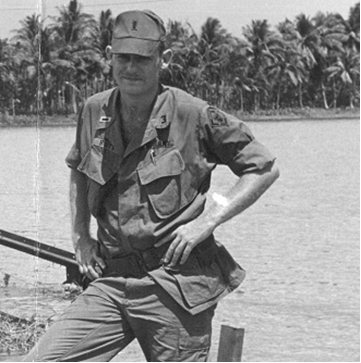|
| This is a dubious anniversary, but fifty years ago today, March 8, 1968, I exchanged my bell-bottoms and tie dyes for Army green and took up an offer from Uncle Sam to see the world. And I did.
I was neither drafted nor did I exactly volunteer. I had previously completed senior ROTC at the University of Arkansas.. The Reserve Officers Training Corps (ROTC) was established in 1873 at the University of Arkansas, as it was in most “land-grant” universities, and during the time I attended (1962-67), ROTC was compulsory for all males during their freshman and sophomore years. There was one class a week in Military Science and one drill a week in good weather.
I spent the first two compulsory years in Air Force ROTC because it looked more intellectually stimulating than Army ROTC. In the fall of 1965; however, Vietnam was heating up and college students were facing the prospect of the draft. After student deferments ran out, people I knew were actually being drafted. Some of my contemporaries got married and started families, at least partially to immunize themselves from the draft. Others joined the National Guard or Army Reserve, took basic training during summer vacation, and spent the next few years at monthly weekend drills and annual summer camps.
Like some of my friends, I concluded that if we were going to be drafted anyway, we might as well go as officers. For the advanced course, I switched to Army ROTC because it only required a two-year commitment versus the Air Force five-year commitment. Enrollment in advanced ROTC paid $27.90 a month, a decent beer allowance in those days, for doing the same thing we had done for free during the two years of “basic” ROTC. In 1967, General Westmoreland had been famously quoted “there is light at the end of the tunnel” in Vietnam. We were naïve enough to believe him. By the time I finished architecture school in 1967, I figured the war would probably be over, and I would get an interesting assignment in Europe with weekends off to roam around Paris, Berlin and Madrid.
A month before induction, I left my architectural position with the firm of Edward Durrell Stone in Palo Alto, bought Frommer’s “Europe on $5 a Day,” and headed for Europe. I traveled through England, France, Spain and Portugal by train and hitchhiking. I barely got back to the U.S. on time.
A haircut later, I became a soldier. My first assignment was six weeks at the Engineer Officer Basic Course at Fort Belvoir near Washington, DC, where we learned how to build things and then blow them up. It was a nice place and kind of fun. Washington, DC was a short drive away.
Next they sent me to Fort Polk, LA, a place that for decades has made the list as the worst military base in the world at which to be stationed. Instead of taking advantage of my education as an architect and training as an Army Engineer, the Army, in its infinite wisdom, assigned me as a basic combat training officer where I was responsible for teaching clueless recruits to march, shoot and fight. I was only slightly less clueless, myself.
Later in 1968, I got transferred to the “Fort Polk Master Plan Team,” a small group of architects, engineers and planners who were trying to figure out what Fort Polk would look like as “permanent” military post. We never figured it out, but it was good duty while it lasted.
Then I finally got my chance to “see the world” with orders to report to Vietnam on my 25th birthday in March of 1969, a year after I entered military service. Not the best birthday present I’ve ever received, but maybe the most memorable. Finally in Vietnam, I landed a job that actually utilized my professional training and education. For the next year, I worked in the operations section of an engineer group headquarters that was responsible for some 3,000 Army engineer troops and about the same number of employees of civilian contractors. Mostly, we were building infrastructure -- roads and bridges -- in anticipation of the US pullout that would leave the Vietnamese in charge of their own fate. And you know how that turned out.

A year later, in March of 1970, I took a discharge in Vietnam (an almost unheard of move) and spent the next few months traveling to Cambodia, Thailand, Hong Kong, China, Japan, the USSR, Austria, Yugoslavia, Greece, Italy and Germany. I did, in fact, see the World – or at least a large part of it.
For a more detailed account of my adventures, including lots of videos, click here.
|

